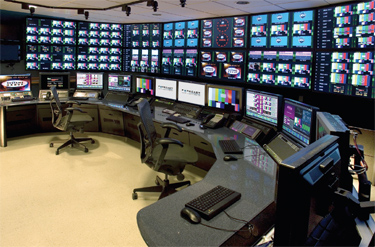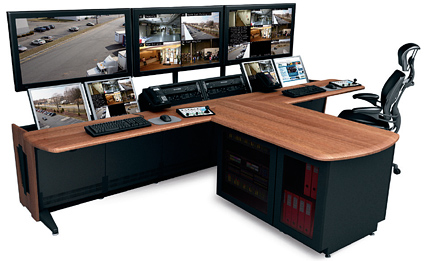IT Driving Changes to Broadcast Furniture
OTTAWA—TV production technology is becoming increasingly IT-driven, with computers and their peripherals taking over master control rooms and editing suites. In response, broadcast production consoles and related furniture are changing to better support and house IT-based equipment.

ABC-New York’s HD Master Control Room includes a front console from Forecast Consoles that employs a low profile equipment turret with rear extrusion for LDC Arm mounting. Monitors housed in a Forecast Consoles Sightline accommodate the mounting of LC D monitors. "The worlds of TV production and IP/IT are merging," observes Bill Haberman, President/CEO of Forecast Consoles in Hauppauge, NY. "This means that today's broadcast furniture must accommodate a wide range of computer technology, including PC workstations, keyboards and flat panel monitors. That's a big change from the analog days, when CRTs and large format switchers/mixers dictated how broadcast furniture was made."
At the same time, "there's a big difference between professional consoles and a PC work station," says Randy Smith, president of Winsted Corp. in Minneapolis. "Most editing systems look and feel like a PC, but in a broadcast environment these consoles are used for very long hours with tight deadlines. [To deal with this fact] Winsted takes into account the operator's workflow, wire management, ergonomics and durability."
Look at the major broadcast furniture manufacturers' websites, and you will see just how much IT is influencing their current product lines.
Forecast Consoles' MASTERail system uses steel frames to support highly configurable, flexibly laid-out master control suites for both TV and radio production—allowing it to handle flat panels, keyboards and CPUs with ease. The system's aluminum extrusion plates provide support for upper turrets, console support arms and accessories. The MASTERail system is then finished using countertops, end panels, removable doors and modesty panels; all with their hardware preinstalled.
The company's goal is to create work spaces that are specific to each application, yet usable by a wide range of personnel. "No longer are we building customized workstations," Forecast Consoles' Haberman says. "In today's 24/7 production environment, 3-4 people may use the same station during a day. So the furniture has to have the ergonomic flexibility to accommodate this fact, because each operator is physically different in size and shape."
To keep up with television's transition into IT and environmental responsibility, Middle Atlantic has unveiled its new line of ViewPoint consoles. These modular units are based upon fully-welded Uni-Frame workstation bays to simplify installation and configuration. The ViewPoint line comes with wedges, bay extenders for rackmounting deeper equipment, turrets for smaller equipment, work surfaces tailored to each system, side panels, and monitor mounts.
Besides its flexibility, ViewPoint consoles are seismic certified to UBC, CBC, IBC, ASCE and NFPA requirements. They also meet BIFMA standards and are GREENGUARD certified; allowing them to be used to obtain LEED (Leadership in Energy & Environmental Design) credits.
THE SOFTWARE INFLUENCE

Middle Atlantic Products’ new ViewPoint consoles are modular units based upon fully-welded Uni-Frame workstation bays to simplify installation and configuration. TBC Consoles' Trac Series is a family of technical furniture products specifically designed for video production and broadcast facilities. The company's IntelliTrac, SmartTrac, and TracWall lines all use t-slotted aluminum extrusion (Trac) to help create all kinds of control room consoles, edit desks and flat panel monitor walls. All Trac Series products integrate with each other, to deliver highly adaptable furniture solutions.
"Equipment and software have freed the console from housing a great deal of equipment," says Pete Pedisich, TBC Consoles' Senior Designer. "In particular the front-to-back depth of the console is being reduced, and our IntelliTrac console is available in several depths to accommodate this. We are also seeing a continuation of the trend towards larger and wider monitors, which now determine the width of a typical console position more often than the traditional 'rack bay' width."
Winsted Corp. keeps updating its broadcast furniture to stay abreast of the latest customer demands. "The trend is larger and larger LCDs with the wider aspect ratio," Smith said. "We have an aluminum track system in the back of our Prestige console to allow the user to adjust for different size LCDs."
The company's line of Ascend broadcast furniture allows operators to choose between sitting or standing at the work area, simply by pushing a button to raise or lower the work surface. This flexibility reduces operator fatigue, by letting them move around during the work shift.
Today's broadcast production furniture is light years' away from the boxy steel cages and cabinets that housed the CRTs and dedicated switchers/mixers of yesteryear. Yet, at the same time, they provide a broadcast-centric design that conventional IT furniture doesn't provide. Buying a generic PC desk from Office Depot and then hoping it will work for TV broadcast just won't cut it.
Get the TV Tech Newsletter
The professional video industry's #1 source for news, trends and product and tech information. Sign up below.
James Careless is an award-winning journalist who has written for TV Technology since the 1990s. He has covered HDTV from the days of the six competing HDTV formats that led to the 1993 Grand Alliance, and onwards through ATSC 3.0 and OTT. He also writes for Radio World, along with other publications in aerospace, defense, public safety, streaming media, plus the amusement park industry for something different.

